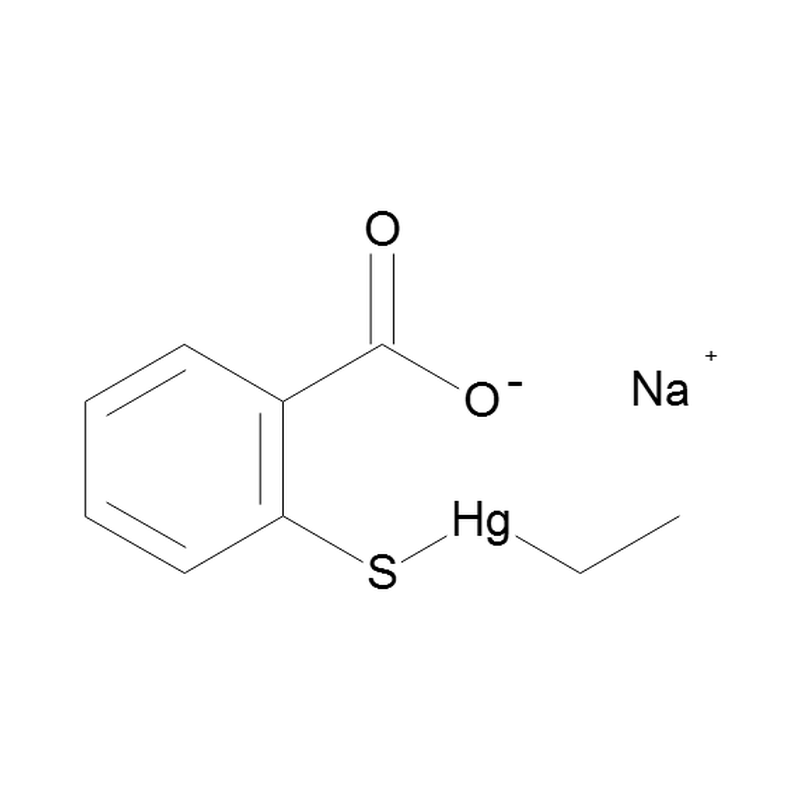产品
编 号:F386203
分子式:C11H15HgNaO2S
分子量:434.88
分子式:C11H15HgNaO2S
分子量:434.88
产品类型
规格
价格
是否有货
50mg
询价
In-stock
100mg
询价
In-stock
500mg
询价
In-stock
结构图

CAS No: 54-64-8
产品详情
生物活性:
Thimerosal, a mercury-containing vaccine preservative, is a suspected factor in the etiology of neurodevelopmental disorders.
体内研究:
The Thimerosal (THIM) administration increases μ-opioid receptors (MORs) density in the periaqueductal gray (PAG) in a dose-dependent manner. Treatment with higher doses of Thimerosal statistically significantly increases MOR density in the dorsomedial periaqueductal gray (DMPAG) andlateral periaqueductal gray (LPAG) regions. At the dose 3,000 μg Hg/kg, Thimerosal also augments MOR density in the caudate putamen (CPU). In contrast, the administration of Thimerosal at both higher doses decreases MOR density in the dentate gyrus (DG). Thimerosal administration (4 injections, i.m., 240 μg Hg/kg on postnatal days 7, 9, 11, 15) induces lasting changes in amino acid overflow: an increase of glutamate and aspartate accompanied by a decrease of glycine and alanine; measured 10 to 14 weeks after the injections. Four injections of Thimerosal at a dose of 12.5 μg Hg/kg do not alter glutamate and aspartate concentrations at microdialysis time. Application of Thimerosal to the prefrontal cortex (PFC) in perfusion fluid evokes a rapid increase of glutamate overflow. Coadministration of the neurosteroid, dehydroepiandrosterone sulfate (DHEAS; 80 mg/kg; i.p.) prevents the Thimerosal effect on glutamate and aspartate; the steroid alone has no influence on these amino acids. Coapplication of dehydroepiandrosterone sulfate (DHEAS) with Thimerosal in perfusion fluid also blocks the acute action of Thimerosal on glutamate.
Thimerosal, a mercury-containing vaccine preservative, is a suspected factor in the etiology of neurodevelopmental disorders.
体内研究:
The Thimerosal (THIM) administration increases μ-opioid receptors (MORs) density in the periaqueductal gray (PAG) in a dose-dependent manner. Treatment with higher doses of Thimerosal statistically significantly increases MOR density in the dorsomedial periaqueductal gray (DMPAG) andlateral periaqueductal gray (LPAG) regions. At the dose 3,000 μg Hg/kg, Thimerosal also augments MOR density in the caudate putamen (CPU). In contrast, the administration of Thimerosal at both higher doses decreases MOR density in the dentate gyrus (DG). Thimerosal administration (4 injections, i.m., 240 μg Hg/kg on postnatal days 7, 9, 11, 15) induces lasting changes in amino acid overflow: an increase of glutamate and aspartate accompanied by a decrease of glycine and alanine; measured 10 to 14 weeks after the injections. Four injections of Thimerosal at a dose of 12.5 μg Hg/kg do not alter glutamate and aspartate concentrations at microdialysis time. Application of Thimerosal to the prefrontal cortex (PFC) in perfusion fluid evokes a rapid increase of glutamate overflow. Coadministration of the neurosteroid, dehydroepiandrosterone sulfate (DHEAS; 80 mg/kg; i.p.) prevents the Thimerosal effect on glutamate and aspartate; the steroid alone has no influence on these amino acids. Coapplication of dehydroepiandrosterone sulfate (DHEAS) with Thimerosal in perfusion fluid also blocks the acute action of Thimerosal on glutamate.
产品资料


